After the French left North Vietnam following the Geneva Agreement that was finalized on July 21st, 1954 the Viet Minh Government under Ho Chi Minh entered Hanoi on October 9th, 1954 and liberated the city. Apparently the Vietnamese Postal Authorities still had lots of mint stamps of the 3rd Ho Chi Minh series on hand (mostly second printing of 100D brown and 200D orange-red) that were denominated in “Old Dong” that was devalued by 10:1 in May of 1951. Since raw material, such as paper and ink, was very scarce the Government decided that the old stamps should be used up by revaluing them in “New Dong” which had already been issued in 1951 following decree 15/SL on May 6, 1951 by Ho Chi Minh that established the National Bank of Vietnam (Democratic Republic of Vietnam Coin and Currency Catalogue, Howard Daniels). In order to do so they provided very small hand stamps to post offices that still had existing old stock. Michel lists that these overprints were issued in October of 1954 and that makes sense. It is likely that the overprints were made in the second half of the month as one would have to assume that the returning Viet Minh Government needed a few days to sort out postal affairs upon returning. The 100D brown and green stamps were overprinted in red ink, while the 200D orange-red stamp was overprinted in black ink. 10 New Dong red (oxidized to redish-brown over time) on 100 Dong brown 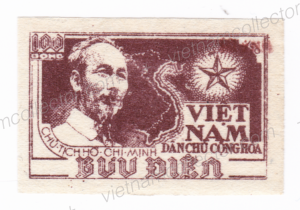
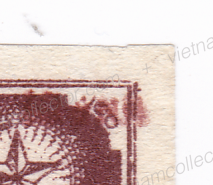 10 New Dong red on 100 Dong green:
10 New Dong red on 100 Dong green: 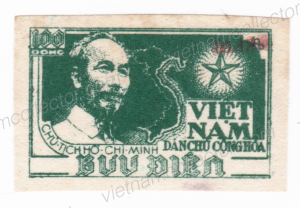
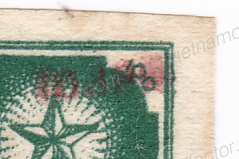 20 New Dong black on 200 Dong:
20 New Dong black on 200 Dong: 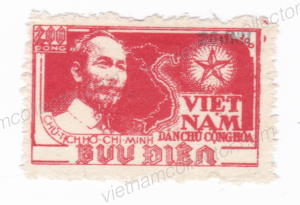
These stamps were produced to order as dictated by daily requirements. These were not great as the domestic letter rate was increased from 100 nDH to 150 nDH in October of 1954 so these stamps that only had nominals of 10 or 20 nDH were basically used as partial supplemental postage on international postcards. Customers mostly purchased these stamps for immediate use which makes them mint more rare than used. This is unusual for early North Vietnam stamps. For the same reasons larger mint units of these stamps are very hard to find. Here are rare mint blocks of four of all three stamps.
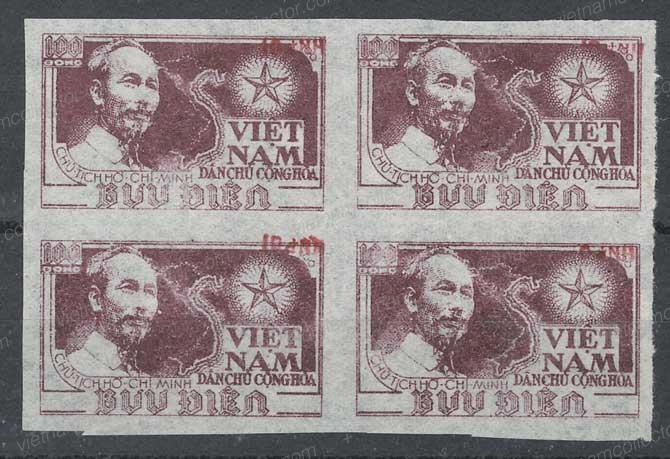
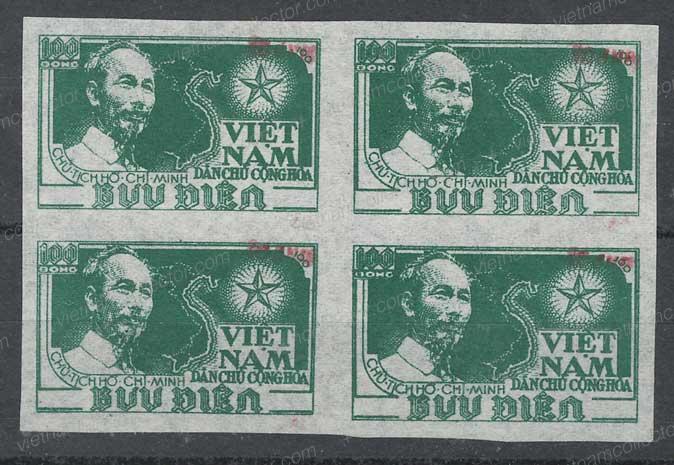
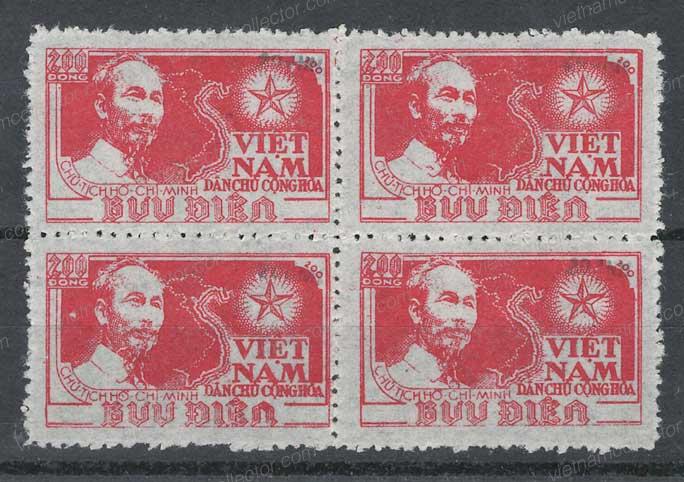 Below are two very rare pairs of the imperforate 200D stamp with the overprint. This version of the stamp is so far not listed in any of the catalogues. Also, recently the editor was able to acquire a postally used and a canceled to order copy of the imperforate version (see below)
Below are two very rare pairs of the imperforate 200D stamp with the overprint. This version of the stamp is so far not listed in any of the catalogues. Also, recently the editor was able to acquire a postally used and a canceled to order copy of the imperforate version (see below)
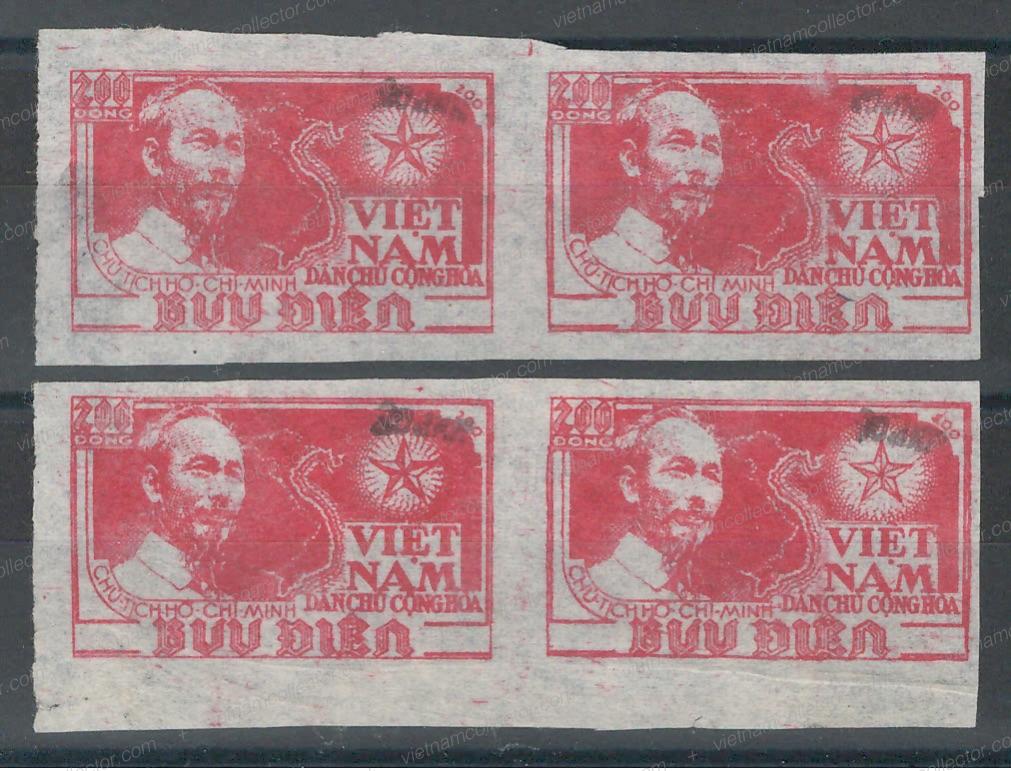
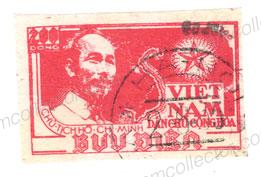
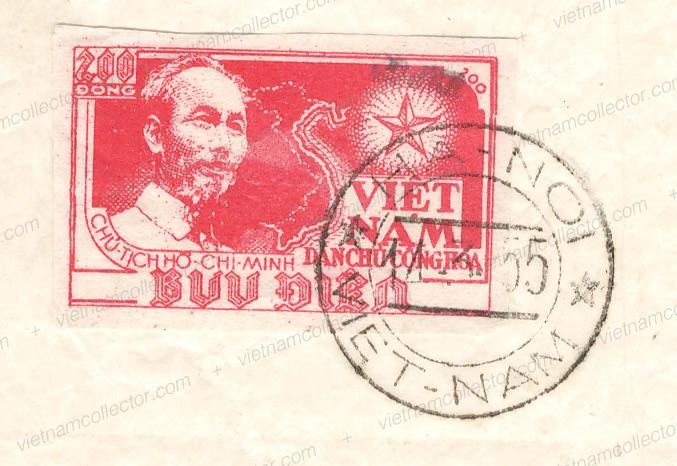
Apart from missing overprints, no other errors of this issue had been reported so far. However, when the editor prepared this article, he noticed that one of the 100 Dong stamps in green had erroneously been overprinted “20 nDH” instead of “10 nDH”. Since the devaluation was 10:1 using a 20 Dong value for a 100 Dong stamp in old currency was incorrect. This is therefore the first valuation error known for these overprints. Very rare. It has been reported to Michel.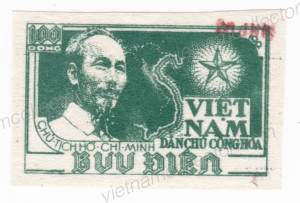
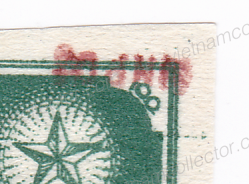
Since these overprinted stamps were only made daily as needed and any units larger than one are hard to find they were not subject to being cancelled to order in complete sheets as other NV N stamps. The only CTO stamps are normally found on philatelic pages such as the one below.
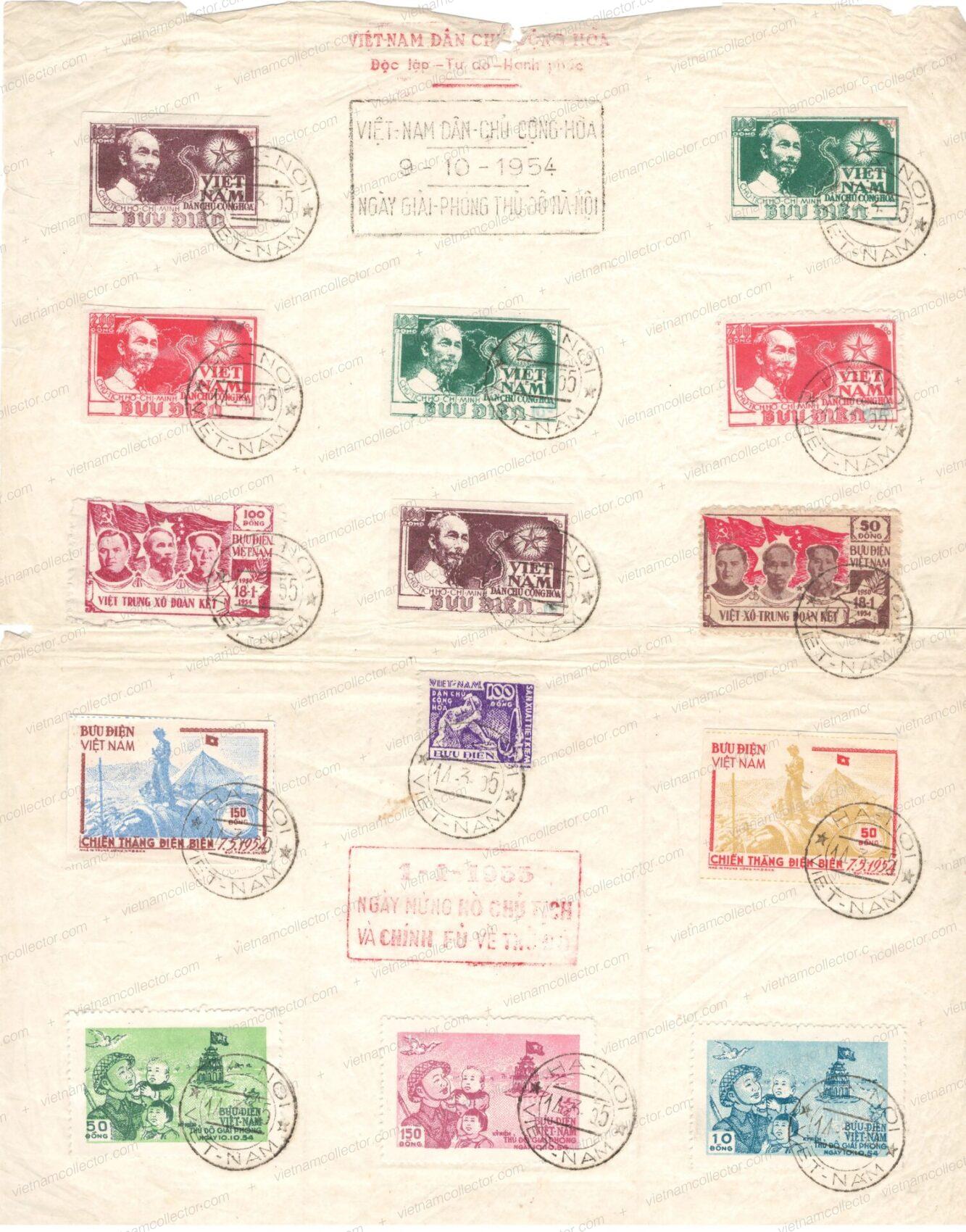
Here are three rare blocks of four where one value in each block is missing the overprint: Top left stamp with missing overprint 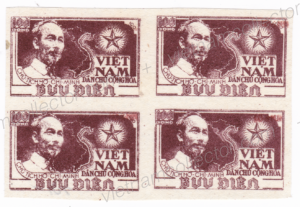 Top right stamp without overprint
Top right stamp without overprint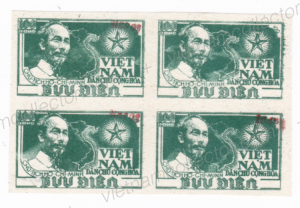 Top left stamp without overprint
Top left stamp without overprint 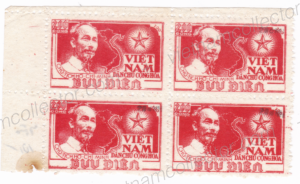 As you can easily see the overprints were basically illegible and they were phased out after only a few days as impractical. Genuine overprints were mostly used from the middle to end of October in 1954 the month they were issued and it appears, all in Hanoi. No usages other than Hanoi have been found so far, so it is likely that the overprints were only sold in the Hanoi post office. It also appears that the overprints were made as needed as very few units larger than one exist. Also, because of their very short time of use, these stamps are a lot more rare than the somewhat larger hand stamps that followed them. This is something that catalogue makers finally have caught on to. They now value the first overp[rints on about par with the second overprints. Not too many mint or used specimens have survived. As a matter of fact here used stamps outnumber mint stamps, which is a seldomly seen situation for early North Vietnam postage stamps. Postally used set :
As you can easily see the overprints were basically illegible and they were phased out after only a few days as impractical. Genuine overprints were mostly used from the middle to end of October in 1954 the month they were issued and it appears, all in Hanoi. No usages other than Hanoi have been found so far, so it is likely that the overprints were only sold in the Hanoi post office. It also appears that the overprints were made as needed as very few units larger than one exist. Also, because of their very short time of use, these stamps are a lot more rare than the somewhat larger hand stamps that followed them. This is something that catalogue makers finally have caught on to. They now value the first overp[rints on about par with the second overprints. Not too many mint or used specimens have survived. As a matter of fact here used stamps outnumber mint stamps, which is a seldomly seen situation for early North Vietnam postage stamps. Postally used set : 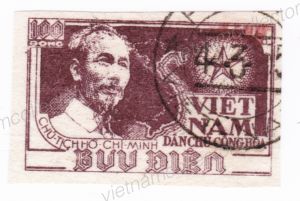
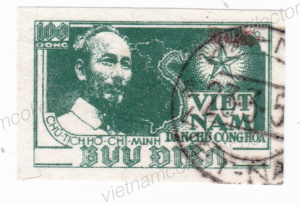
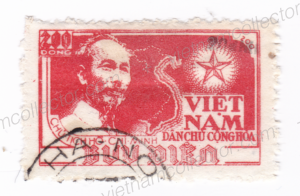 Postally used letters with this issue are extremely rare. Again, there were only about two week these stamps were actually available for sale. From the Klewitz Collection comes a letter that was most likely philatelically inspired (Klewitz was a well know German philatelist specializing in Vietnam). It shows three early North Vietnam stamps (among them a 10 New Dong on 100 Dong brown overprint) that was cancelled on October 9th, 1954. This was the date the Viet Minh Army re-took Hanoi and the French Army left the city. Now, it could be that Viet Minh came just extremely well prepared and the army had hand-stamps and celebratory cachets on hand to reopen the post office on the very same day, but this would have taken extraordinary preplanning to the most minute detail. Also, the letter that is addressed to Klewitz in Germany with 110 Dong which would certainly have been too little postage for a standard letter rate to the West given the fact that the standard domestic letter rate had just been raised from 100 New Dong to 150 New Dong. We know that surface letters to neighboring China already cost 300 New Dong in early 1955. So, clever as Klewitz was, he probably used one of his local contacts to get the cover cancelled with a back-dated cancel after the fact in order to document the exact day of “Liberation”. Nevertheless, probably unique item.
Postally used letters with this issue are extremely rare. Again, there were only about two week these stamps were actually available for sale. From the Klewitz Collection comes a letter that was most likely philatelically inspired (Klewitz was a well know German philatelist specializing in Vietnam). It shows three early North Vietnam stamps (among them a 10 New Dong on 100 Dong brown overprint) that was cancelled on October 9th, 1954. This was the date the Viet Minh Army re-took Hanoi and the French Army left the city. Now, it could be that Viet Minh came just extremely well prepared and the army had hand-stamps and celebratory cachets on hand to reopen the post office on the very same day, but this would have taken extraordinary preplanning to the most minute detail. Also, the letter that is addressed to Klewitz in Germany with 110 Dong which would certainly have been too little postage for a standard letter rate to the West given the fact that the standard domestic letter rate had just been raised from 100 New Dong to 150 New Dong. We know that surface letters to neighboring China already cost 300 New Dong in early 1955. So, clever as Klewitz was, he probably used one of his local contacts to get the cover cancelled with a back-dated cancel after the fact in order to document the exact day of “Liberation”. Nevertheless, probably unique item. 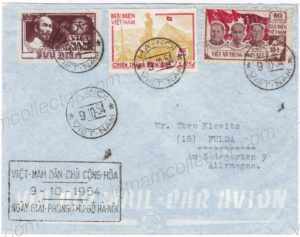 Gregor Schwirtz, another well known German Vietnam philatelist and linguist, who spoke Vietnamese, annotated this philatelic letter in his collection with the words: “On October 9th, 1954, in the morning, the French troops withdrew from Hanoi. After one day of reorganization the post office was reopened on October 11th, 1954.” This statement is most likely correct. “La Philatelie” was a professional stamp outfit and had the special cachet that celebrated the re-taking of Hanoi already been available on September 9th it would have documented that date with philatelic letters. Instead the earliest available philatelic letters from La Philatelie are from October 11th.
Gregor Schwirtz, another well known German Vietnam philatelist and linguist, who spoke Vietnamese, annotated this philatelic letter in his collection with the words: “On October 9th, 1954, in the morning, the French troops withdrew from Hanoi. After one day of reorganization the post office was reopened on October 11th, 1954.” This statement is most likely correct. “La Philatelie” was a professional stamp outfit and had the special cachet that celebrated the re-taking of Hanoi already been available on September 9th it would have documented that date with philatelic letters. Instead the earliest available philatelic letters from La Philatelie are from October 11th. 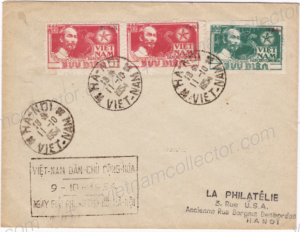 This philatelic envelope was cancelled a few days later on October, 18th, 1954. It features a single copy of the 20 new Dong on 200 old Dong brick-red variety. Also shown is a philatelic envelope that was produced much later using a special cancel that was produced for the emission of the “Wostok 5 and 6 Rocket” stamps dated Marc 25th, 1964. The left stamp is the 10 new Dong on 100 old Dong green variety.
This philatelic envelope was cancelled a few days later on October, 18th, 1954. It features a single copy of the 20 new Dong on 200 old Dong brick-red variety. Also shown is a philatelic envelope that was produced much later using a special cancel that was produced for the emission of the “Wostok 5 and 6 Rocket” stamps dated Marc 25th, 1964. The left stamp is the 10 new Dong on 100 old Dong green variety. 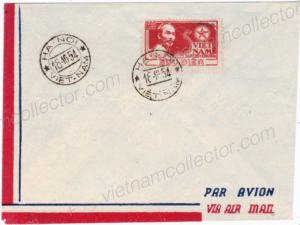
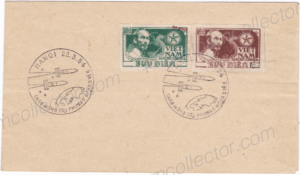 Here is another philatelic product with favor cancelled early North Vietnam stamps. It contains all three overprinted stamps.The brown smears represent gum arabica as these stamps were issued without gum and hence had to be attached using an adhesive.
Here is another philatelic product with favor cancelled early North Vietnam stamps. It contains all three overprinted stamps.The brown smears represent gum arabica as these stamps were issued without gum and hence had to be attached using an adhesive.
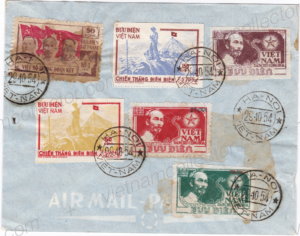 Below is a letter that has the characteristics of a postally used cover. It is the earliest postally used cover the editor has seen and may very well represent the first date of issue for these overprints. It carries five stamps of the 10 Dong on 100 Dong in green for a total of 50 Dong postage. While the national standard letter rate was 100 New Dong (it was raised at the end of October,1954 to 150 New Dong) this represented an intra-city rate that was half of the national rate. The intra-city rate did exist in Indochina and it was a carry-over into the Viet Minh era.
Below is a letter that has the characteristics of a postally used cover. It is the earliest postally used cover the editor has seen and may very well represent the first date of issue for these overprints. It carries five stamps of the 10 Dong on 100 Dong in green for a total of 50 Dong postage. While the national standard letter rate was 100 New Dong (it was raised at the end of October,1954 to 150 New Dong) this represented an intra-city rate that was half of the national rate. The intra-city rate did exist in Indochina and it was a carry-over into the Viet Minh era.
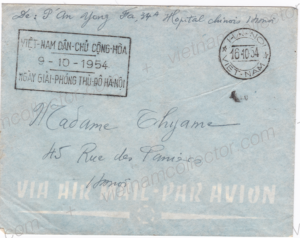
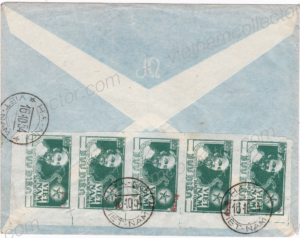 Because the first overprint issue was basically a flop caused by illegible overprints the postal administration issued new hand stamps in the same month that replaced the old ones. Unfortunately they did not specify the colors that had to be used to apply the overprint and therefore, depending on availability at the time, postal clerks used blue, black and red ink pads which explains the various varieties that exist on these stamps. Given that the 10D and 20D nominals were of little use because the standard domestic letter rate was already at 150D in October of 1954 these stamps were produced daily by overprinting the few sheets that the daily demand would require. As a result no complete sheets of the overprint issue have been found. Even smaller units of pairs or blocks of four are pretty rare and hardly ever come to market. It probably takes almost a lifetime to collect all the variations on these stamps as they do not come to market frequently and often the same types appear over and over again. 10 D on 100 Dong lilac brown (blue overprint Type I)
Because the first overprint issue was basically a flop caused by illegible overprints the postal administration issued new hand stamps in the same month that replaced the old ones. Unfortunately they did not specify the colors that had to be used to apply the overprint and therefore, depending on availability at the time, postal clerks used blue, black and red ink pads which explains the various varieties that exist on these stamps. Given that the 10D and 20D nominals were of little use because the standard domestic letter rate was already at 150D in October of 1954 these stamps were produced daily by overprinting the few sheets that the daily demand would require. As a result no complete sheets of the overprint issue have been found. Even smaller units of pairs or blocks of four are pretty rare and hardly ever come to market. It probably takes almost a lifetime to collect all the variations on these stamps as they do not come to market frequently and often the same types appear over and over again. 10 D on 100 Dong lilac brown (blue overprint Type I)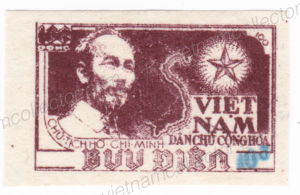
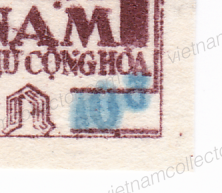
Rare mint block of four of the blue overprint in the lilac brown base stamp.
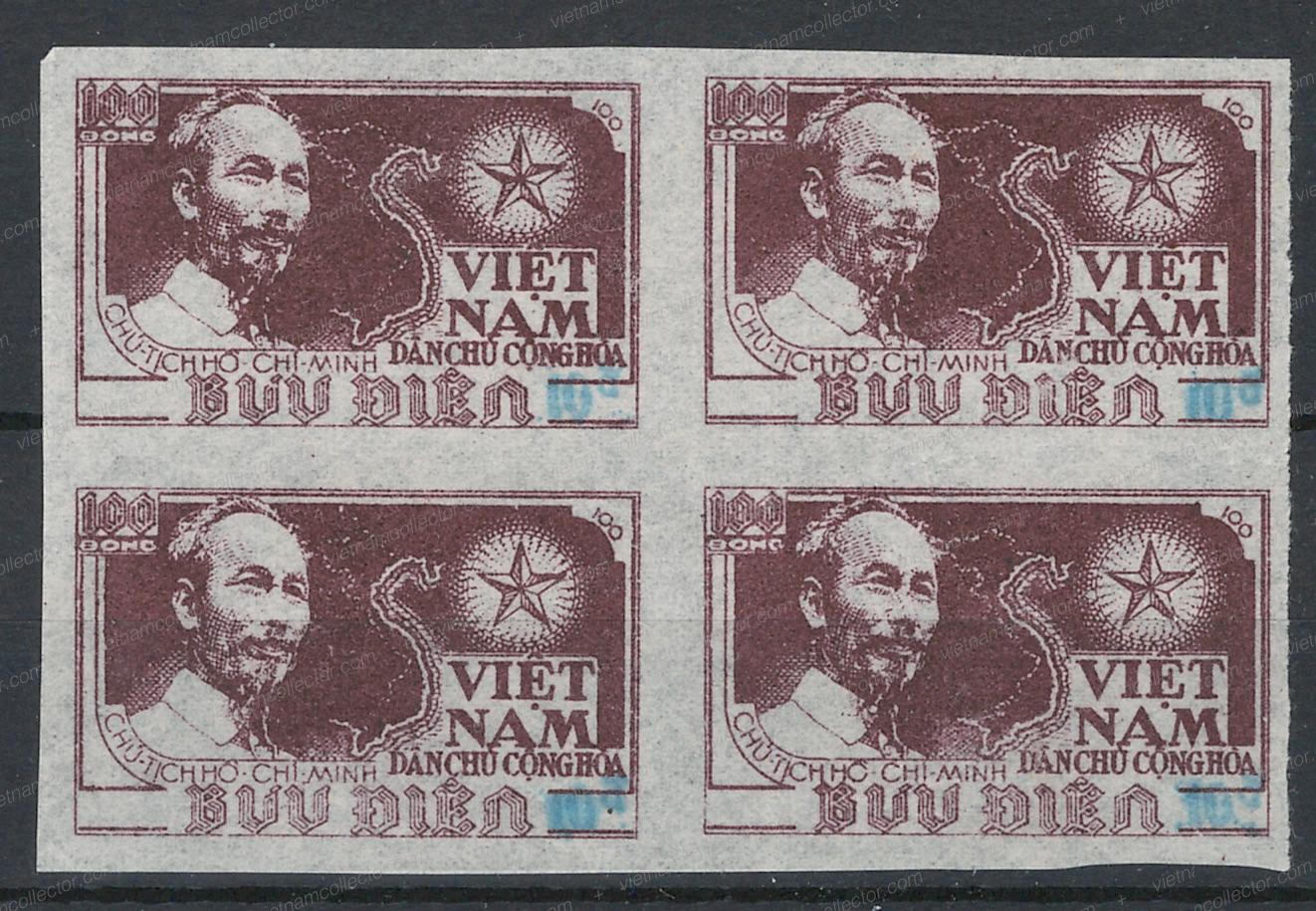
10 D on 100 Dong lilac brown (blue overprint Type II)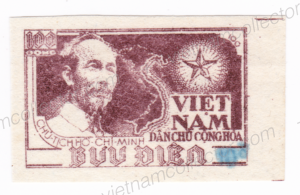
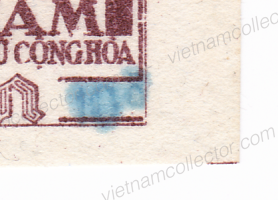 10 D on 100 Dong lilaq brown (black overprint Type I)
10 D on 100 Dong lilaq brown (black overprint Type I) 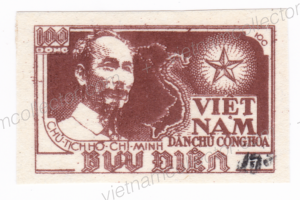
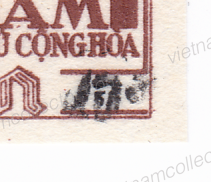 10 D on 100 Dong lilac brown (black overprint Type II)
10 D on 100 Dong lilac brown (black overprint Type II)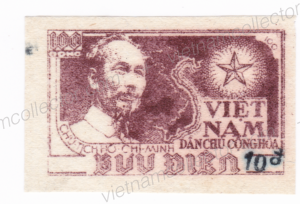
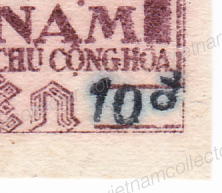
Rare mint block of four of the same stamp in brown base color.
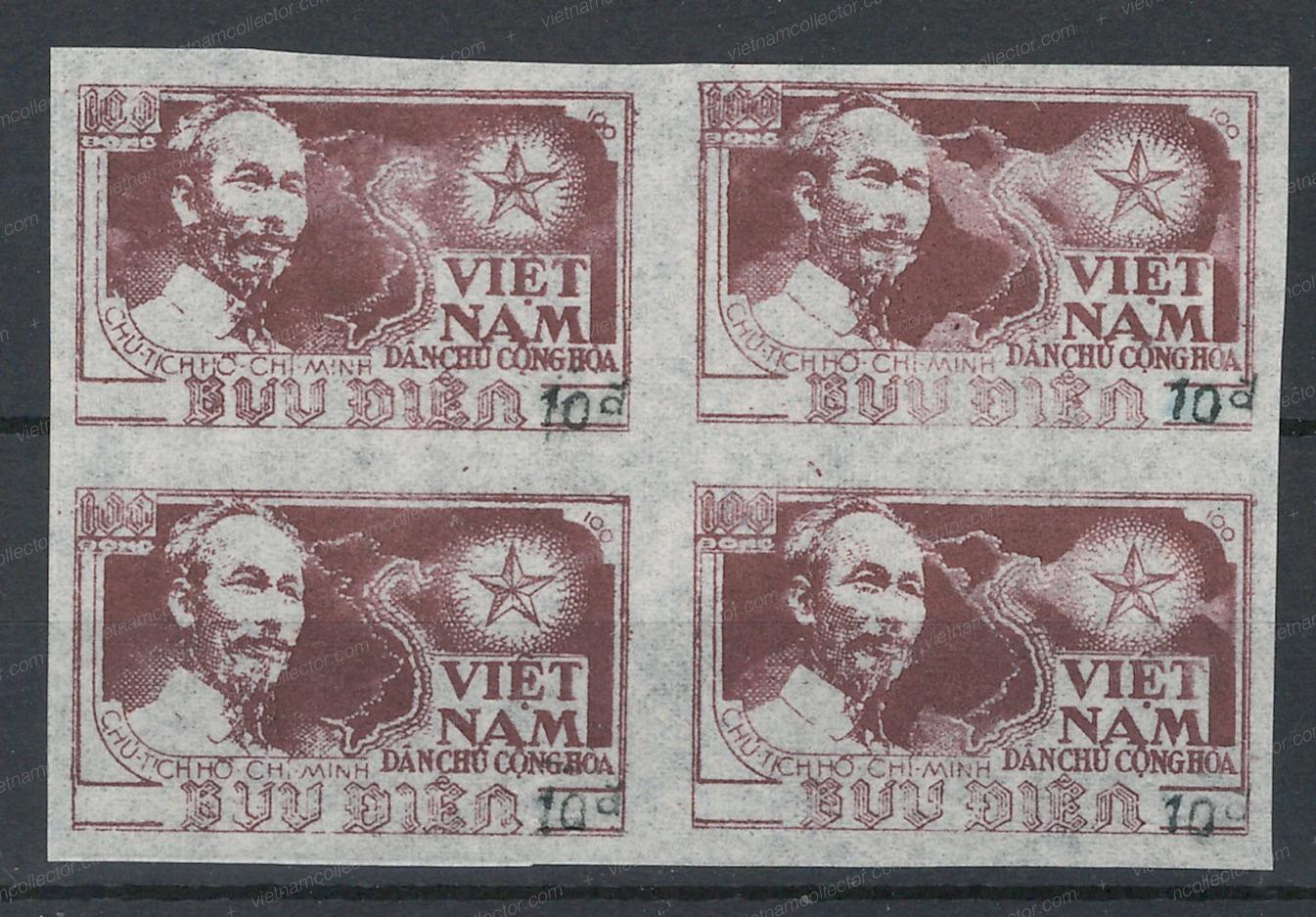
10 D on 100 Dong lilac brown (red overprint Type I-block of four). Multiples of these stamps are very hard to find as they were produced daily by postal clerks as needed.
Here is a rare mint block of four with the red overprint on the brown base color stamp.
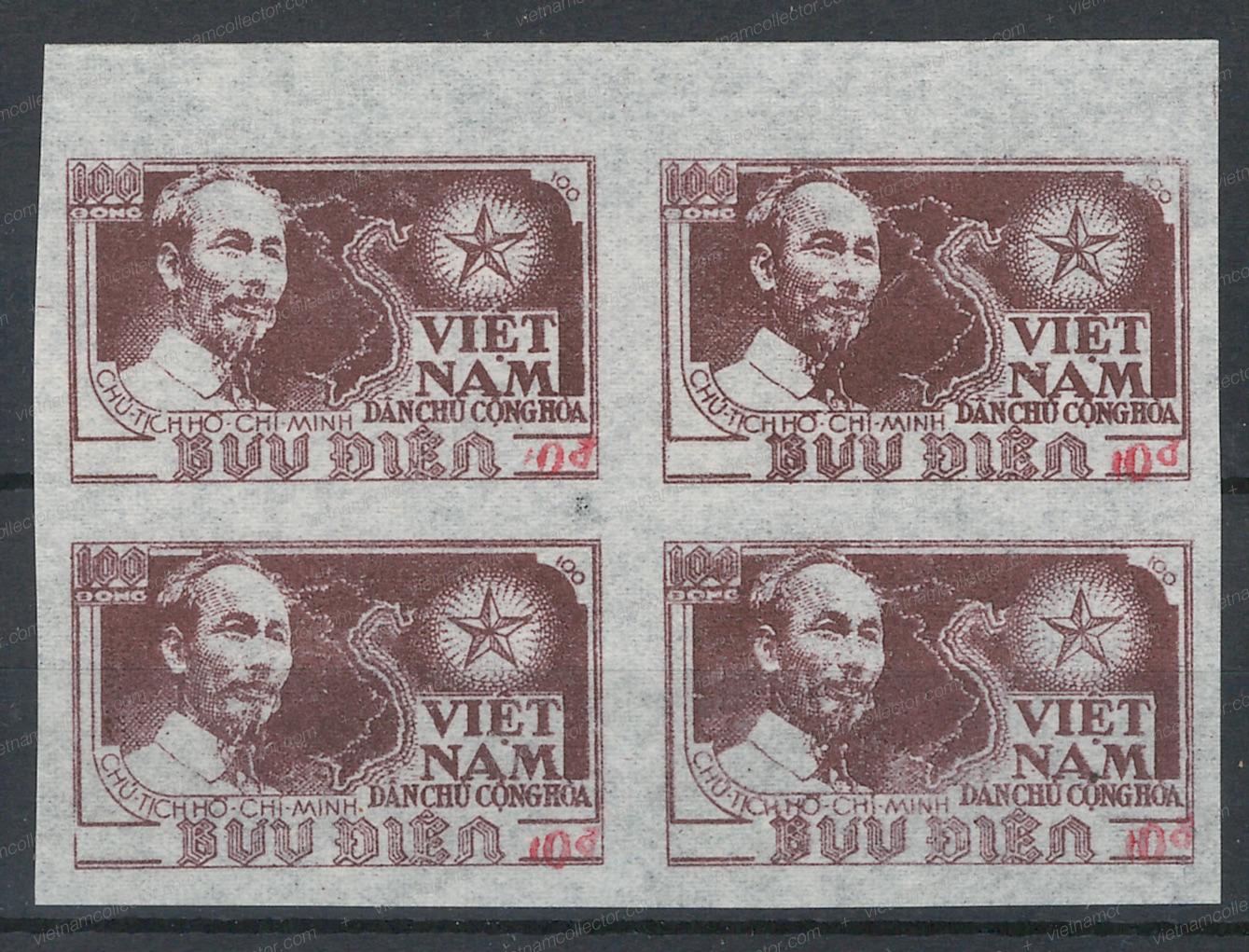
10 D on 100 Dong lilac brown (red overprint Type II)
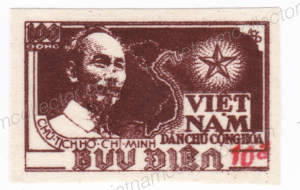
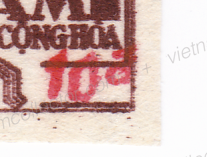 10 D on 100 Dong green (blue overprint Type I)
10 D on 100 Dong green (blue overprint Type I) 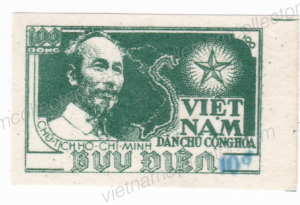
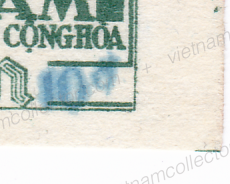
Rare mint block of four of the blue overprint (Type I)
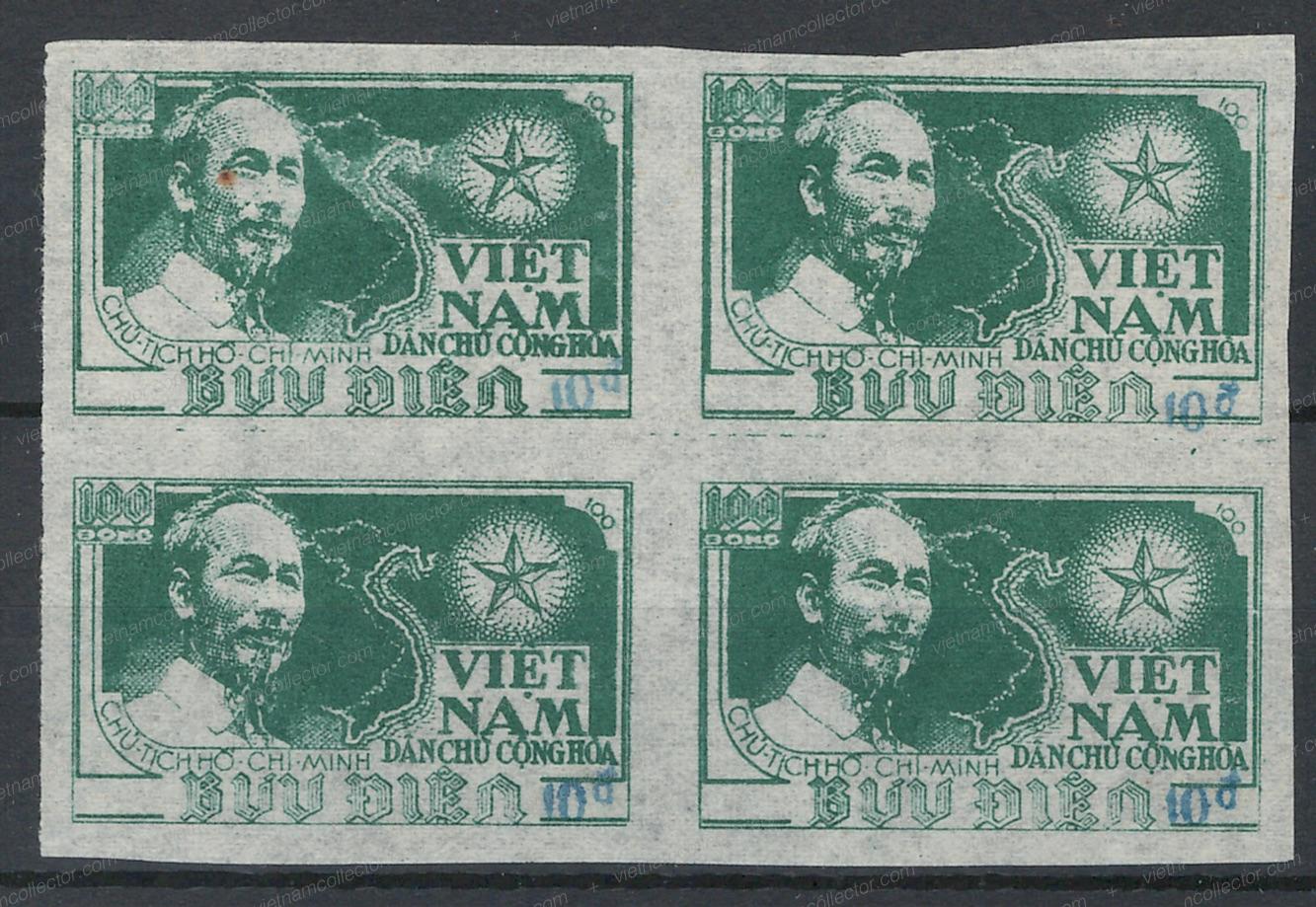
Overprint errors of 10D on 100D green (blue overprint type I). The overprint on this mint and postally used sample was erroneously struck on the upper right instead of the lower right part of the stamps.
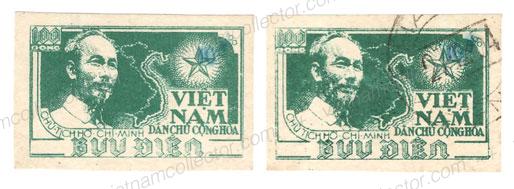
10 D on 100 Dong green (blue overprint Type II) 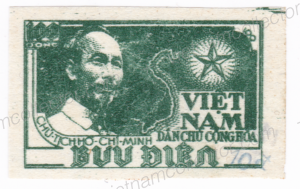
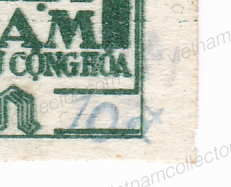 10 D on 100 Dong green (black overprint Type I)
10 D on 100 Dong green (black overprint Type I)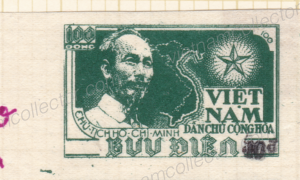
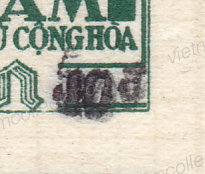 10 D on 100 Dong green (black overprint Type II)
10 D on 100 Dong green (black overprint Type II) 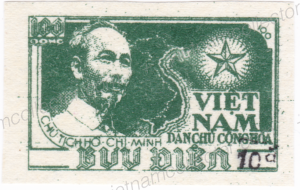
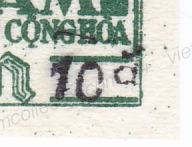
Rare mint block of four with the black overprint (Type II)
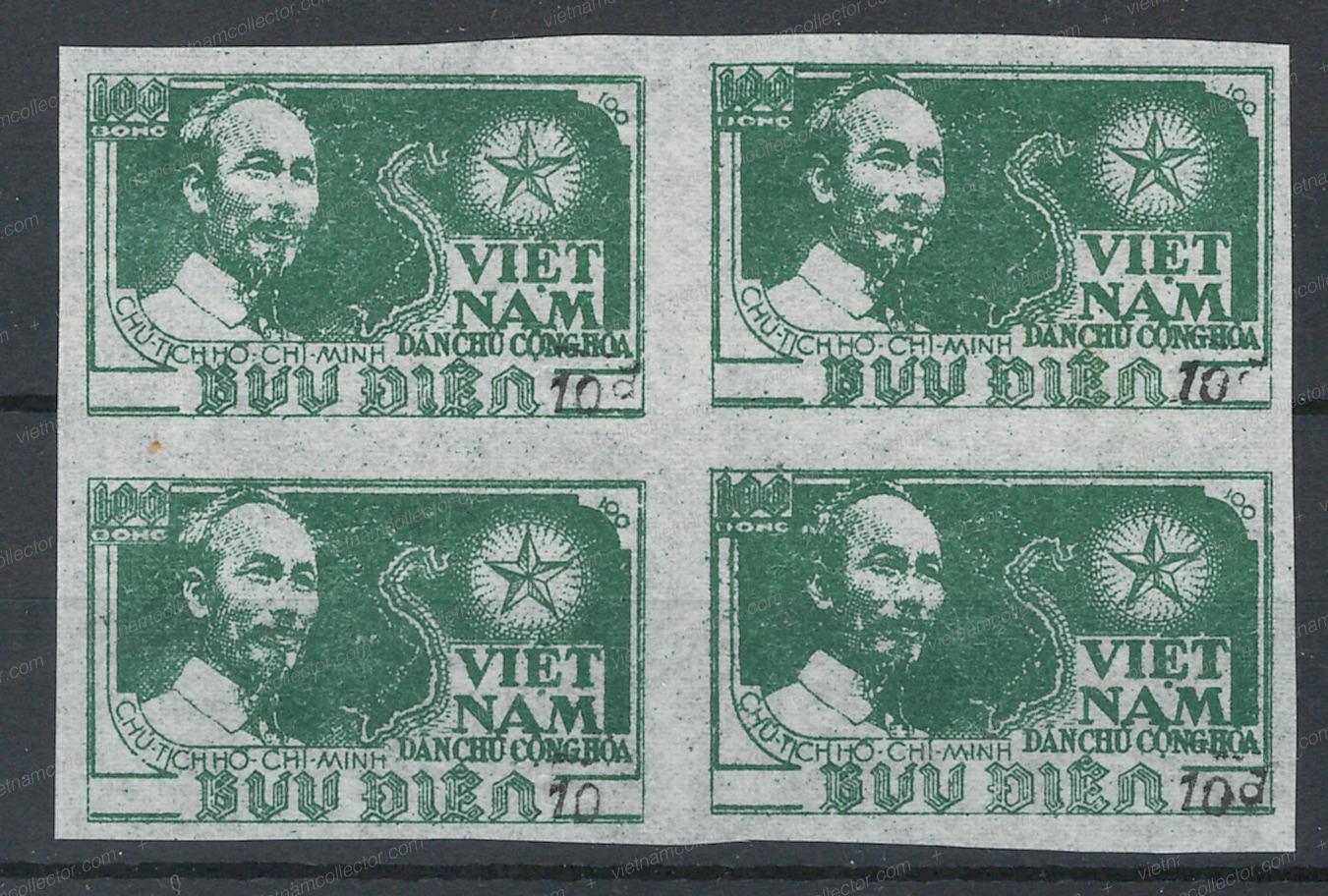
10 D on 100 Dong green (red overprint Type I-pair)
10 D on 100 Dong green (red overprint Type II) 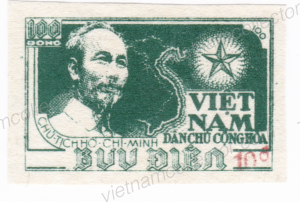
The overprints were not prepared until they were actually needed. This means the post offices overprinted just the amount of stamps that were required by postal customers on a certain day. This was also the reason that the overprints were made in different colors. Michel reports that not always was the same ink pad available. As a result units of multiple stamps are very rare. Below is a exceedingly rare unit of 48 of the Type II stamp that by far represents the largest known unit of this stamp.
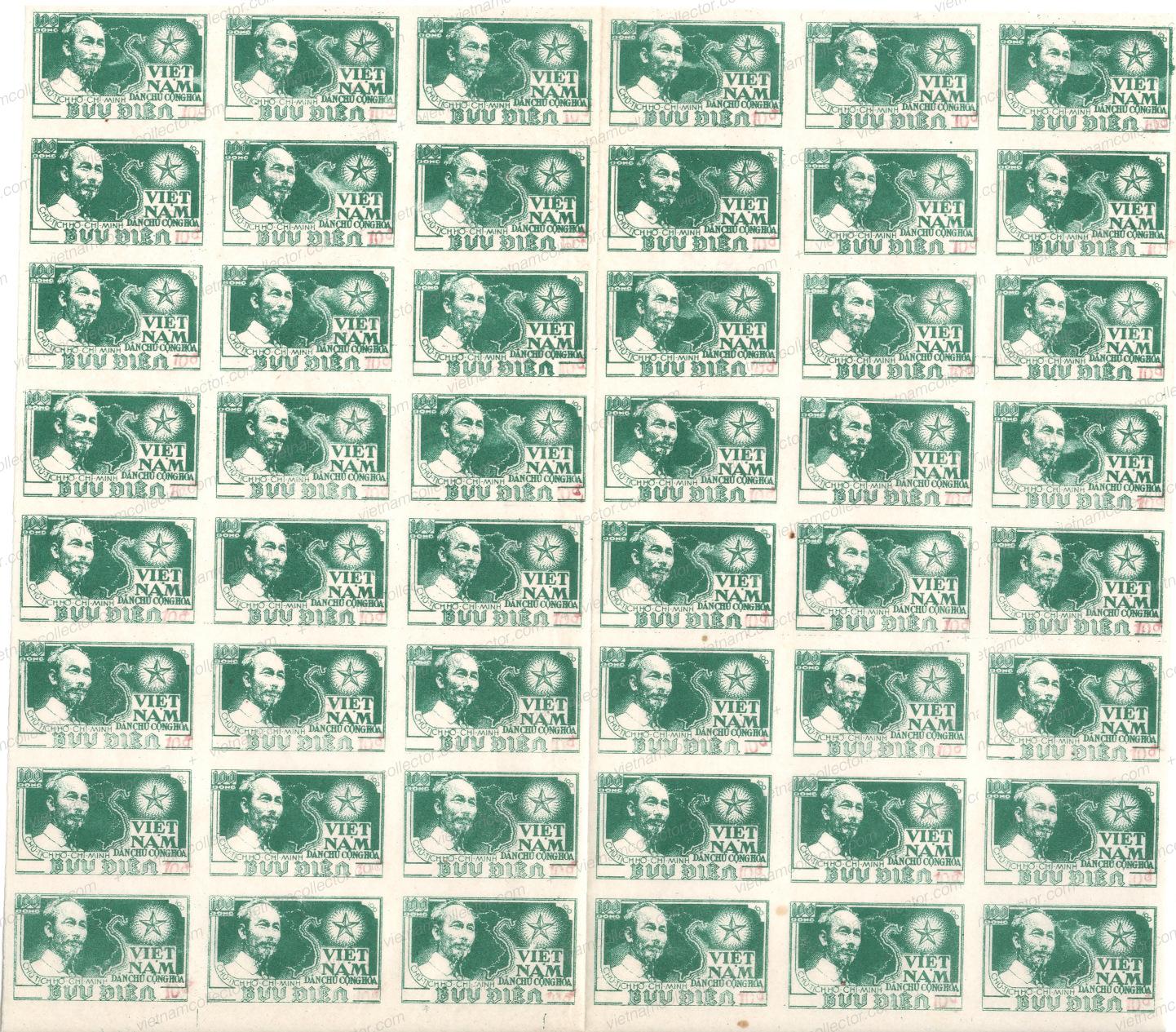
Beware of forged overprints like this one. Note the rounded “O” in “10” and the “d” that looks more like a small “a”. Also, the red color looks fresh and not aged as in the originals.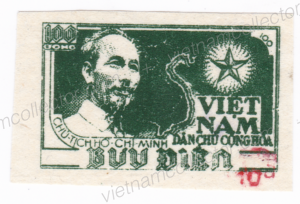
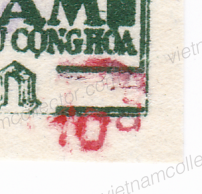 20 D on 200 Dong brick-red (black overprint Type I)
20 D on 200 Dong brick-red (black overprint Type I) 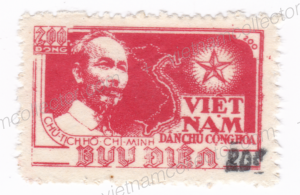
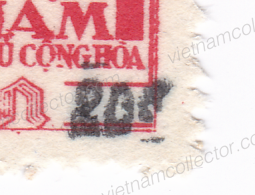
Rare mint block of four of the carmine red stamps (Type I black overprint). Not yet listed by Michel.
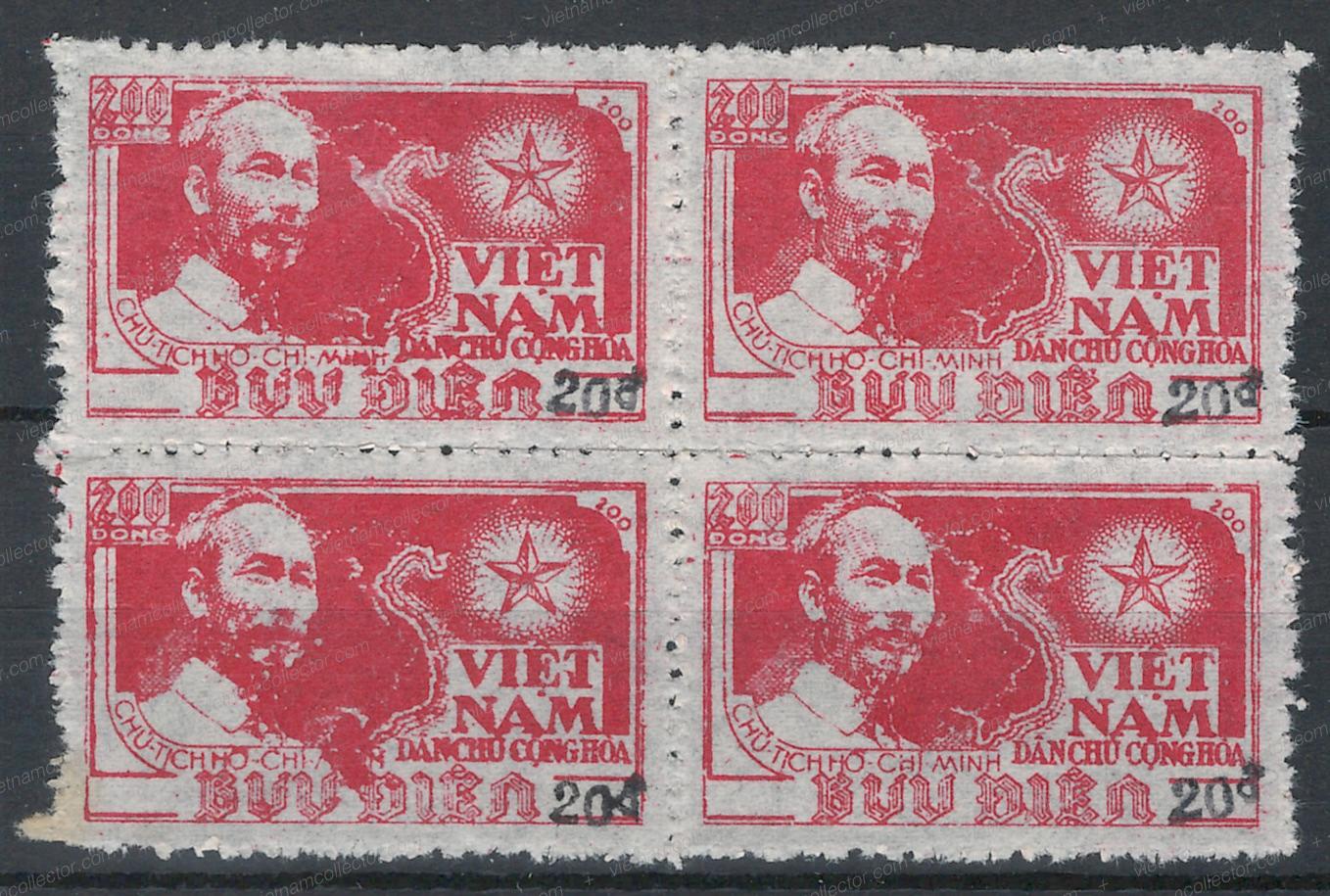
20 D on 200 Dong brick-red (black overprint Type II) 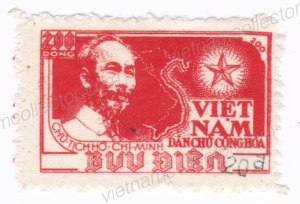
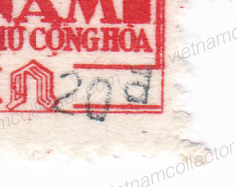
A rare block of four of the 20D on 200D brick-red stamp (black overprint Type II). Any multiples of these stamps are hard to find as they were produced daily as needed by postal clerks
20 D on 200 Dong carmine (black overprint Type II) -Block of four (ex Klewitz).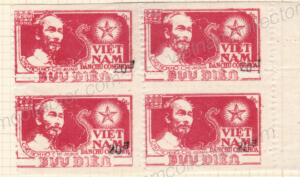
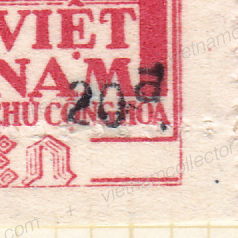 Beware of counterfeit overprints. Here is a forged “20d” overprint simulating Michel Nr. 21 IaI. Note the much thicker looking imprint and the short “d”.
Beware of counterfeit overprints. Here is a forged “20d” overprint simulating Michel Nr. 21 IaI. Note the much thicker looking imprint and the short “d”.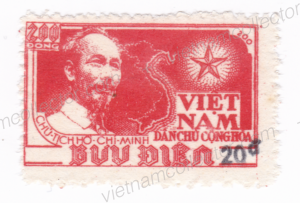
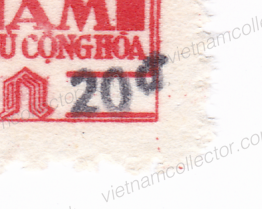 20 D on 200 Dong brick-red (blue overprint Type I)
20 D on 200 Dong brick-red (blue overprint Type I) 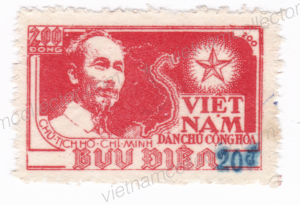
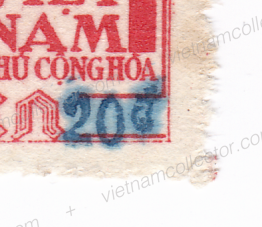
So far, the 20 Dong blue overprint of Type II on the 200D stamp has not be catalogued in Michel however, here is a mint copy on the brick-red base stamp which proofs that it in fact exists:
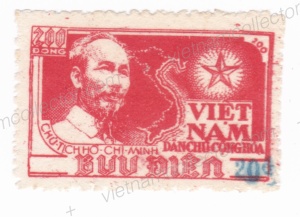 Until now, the 200 Dong stamp was only known with black and blue over-prints however, the editor recently discovered a genuine 200D orange-red stamp with a red overprint (Type II). The over-print is genuine as can be seen by the “0” that is slightly leaning towards the left, a hallmark of the genuine Type II 20 overprint. The stamp has been reported to Michel. As these stamps were overprinted as needed this may represent a unique specimen.
Until now, the 200 Dong stamp was only known with black and blue over-prints however, the editor recently discovered a genuine 200D orange-red stamp with a red overprint (Type II). The over-print is genuine as can be seen by the “0” that is slightly leaning towards the left, a hallmark of the genuine Type II 20 overprint. The stamp has been reported to Michel. As these stamps were overprinted as needed this may represent a unique specimen.
There are a number of errors that do occur on these stamps. Here is the rarest one of them all. Although the devaluation ratio was 1:10 in this case the postal clerk made a mistake. Instead of applying a “20 d” hand stamp he/she used a “10d” hand stamp. This, of course, undervalued the stamp by half. This stamp received it’s own catalogue number by Michel but this is incorrect as errors normally do not get their own catalogue number but only a sub-number. The error was, however, caught quickly as only a handful of the error stamps were sold in this fashion. The editor has never seen a cancelled version of this stamp.This suggests that it was only released for postal use after it had been corrected (see below). Below is the error stamp in the red and orange-red base color. The orange-red base color with the error is so far unlisted in Michel.
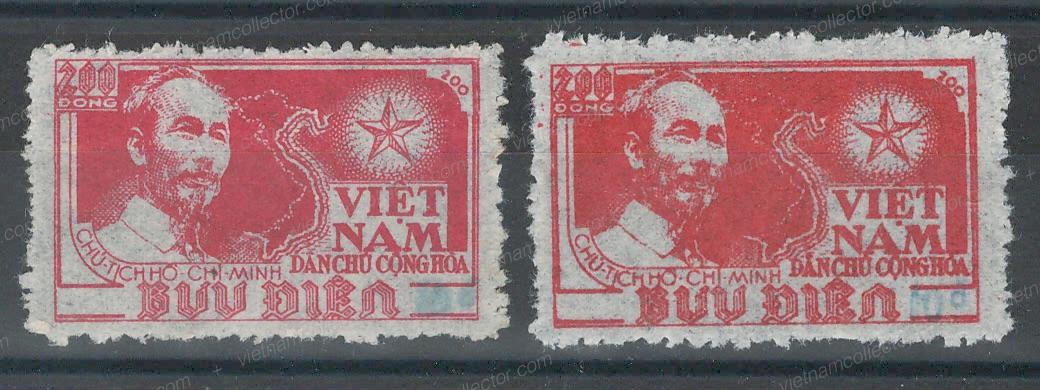
Detailed scan of the error overprint
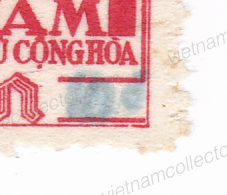 After the 10 Dong blue hand-stamp had been applied to the stamp by error the clerk tried to rectify most errors by overprinting it another time with the correct 20 Dong. This ensured that the original error is actually much rarer than the correction. Nevertheless, even the correction is a very scarce stamp, as the daily requirements for the overprinted stamp only amounted to a small number of sheets, so the number of corrected stamps was limited to a few hundred, at the most. Michel gave it, again incorrectly, it’s own number (Michel Nr. 22) but it should be classified as an error instead with a sub catalogue number.
After the 10 Dong blue hand-stamp had been applied to the stamp by error the clerk tried to rectify most errors by overprinting it another time with the correct 20 Dong. This ensured that the original error is actually much rarer than the correction. Nevertheless, even the correction is a very scarce stamp, as the daily requirements for the overprinted stamp only amounted to a small number of sheets, so the number of corrected stamps was limited to a few hundred, at the most. Michel gave it, again incorrectly, it’s own number (Michel Nr. 22) but it should be classified as an error instead with a sub catalogue number. 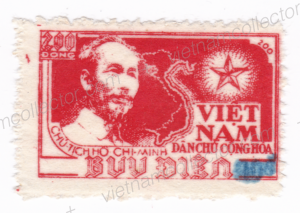
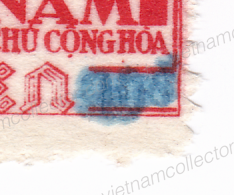
Exceedingly rare mint block of four of the corrected error stamp.
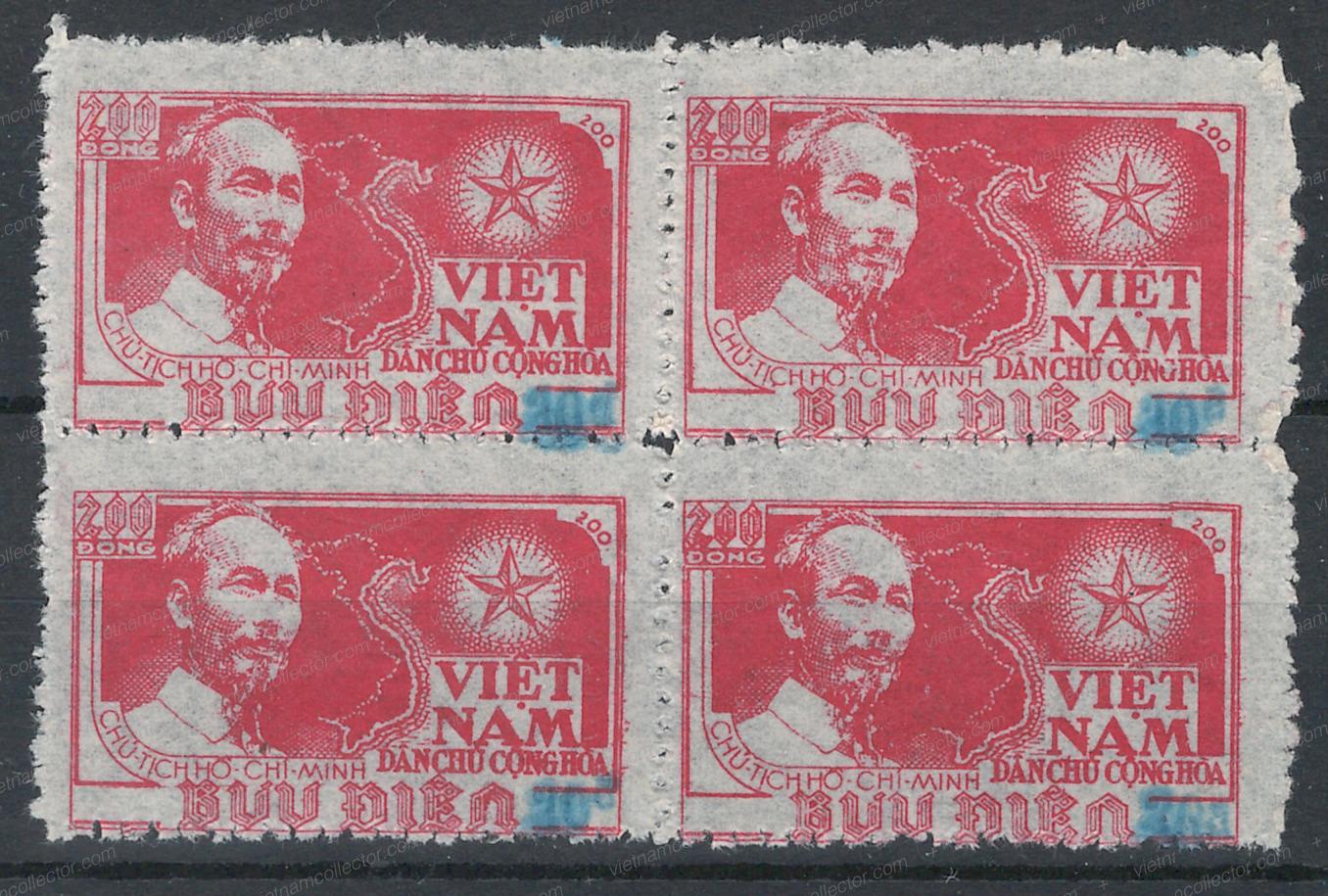
This corrected stamp has been found used, so clearly the corrected version was seen fit for postal traffic. Cancelled stamps of this error are extremely rare. 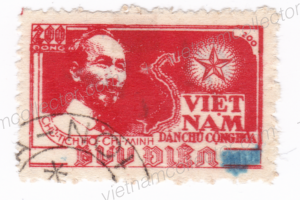
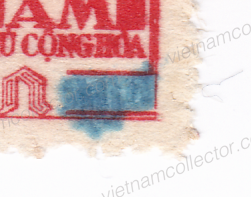 Believe it or not, but there are actually errors on the error stamp. Below is probably a unique 20 Dong on 10 Dong on 200 Dong with another double overprint at the top. Most likely a unique item.
Believe it or not, but there are actually errors on the error stamp. Below is probably a unique 20 Dong on 10 Dong on 200 Dong with another double overprint at the top. Most likely a unique item.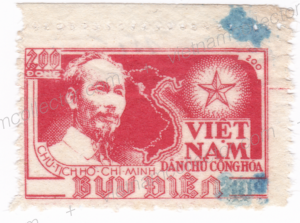 Continues in Part II Registration Nr. 100028
Continues in Part II Registration Nr. 100028

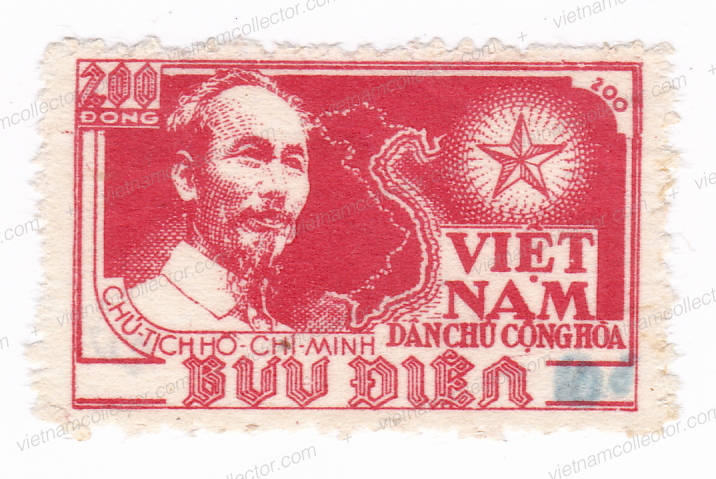
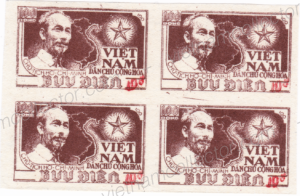
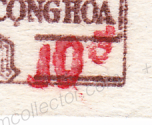
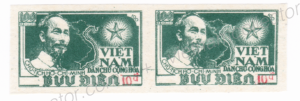
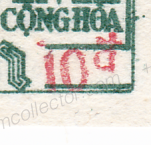
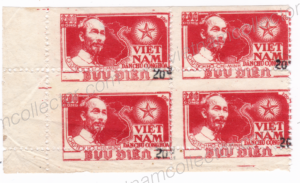
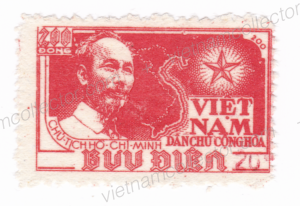
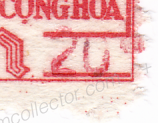
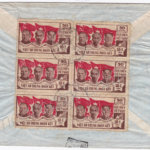

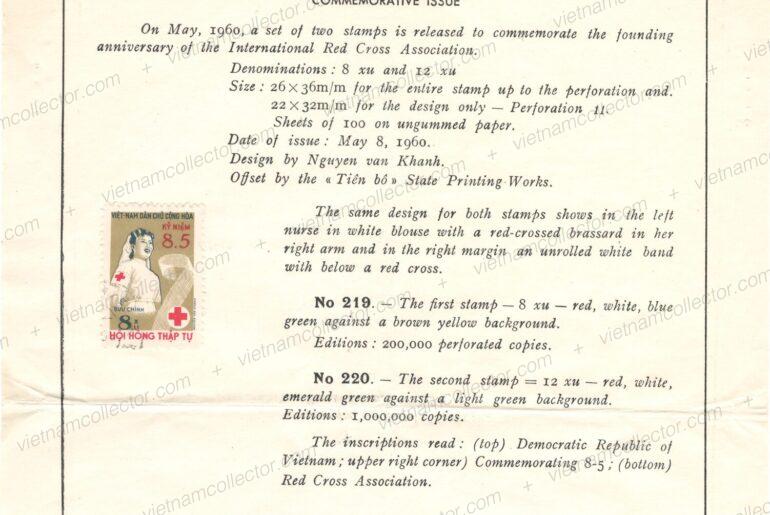
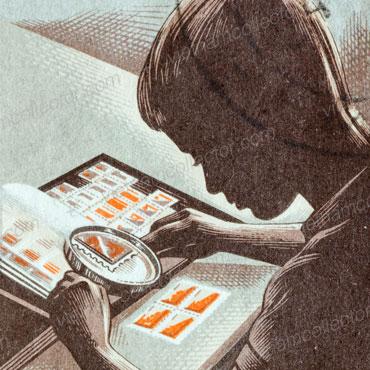
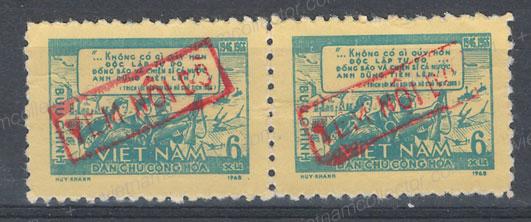
Comments are closed.